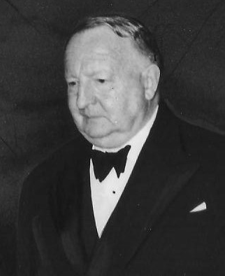Leslie Hollinghurst facts for kids
Quick facts for kids
Sir Leslie Hollinghurst
|
|
|---|---|
 |
|
| Born | 2 January 1895 Muswell Hill, Middlesex |
| Died | 8 October 1971 (aged 76) |
| Allegiance | United Kingdom |
| Service/ |
Royal Air Force |
| Years of service | 1914–52 |
| Rank | Air Chief Marshal |
| Commands held | Air Member for Personnel (1949–52) Inspector-General of the RAF (1948–49) Air Member for Supply and Organisation (1945–48) No. 38 (Airborne Forces) Group (1943–44) No. 9 (Fighter) Group (1943) No. 20 Squadron (1932–35) |
| Battles/wars | First World War Second World War |
| Awards | Knight Grand Cross of the Order of the British Empire Knight Commander of the Order of the Bath Distinguished Flying Cross Mentioned in Despatches (2) Distinguished Flying Cross (United States) Commander of the Order of Leopold (Belgium) Bronze Lion (Netherlands) Officer of the Legion of Honour (France) Croix de guerre (France) |
Sir Leslie Norman Hollinghurst was a very important leader in the Royal Air Force. He was also a brave flying ace during the First World War. A flying ace is a pilot who shoots down many enemy aircraft. He was born on January 2, 1895, and passed away on June 8, 1971.
Contents
Early Life and First World War Adventures
Leslie Hollinghurst was born in Muswell Hill, England, in 1895. He was one of three children. When the First World War began in 1914, he joined the Royal Engineers. He took part in the Gallipoli landings. He was also wounded while fighting in Salonika.
In 1916, he became an officer in the Middlesex Regiment. Later that year, he joined the Royal Flying Corps (RFC). This was the air force before it became the RAF. He learned to fly planes while serving in Egypt. He became a captain in No. 87 Squadron. He flew Sopwith Dolphin planes.
Hollinghurst was a very skilled pilot. He shot down four enemy planes. For his bravery, he received the Distinguished Flying Cross in October 1918. By the end of the war, he had shot down 11 enemy aircraft. His brother, Charles, also served in the RFC and won awards. His sister, Phyllis, joined the Women's Royal Air Force.
Between the Wars: Service and Promotions
After the First World War, in 1919, Leslie Hollinghurst officially joined the new Royal Air Force. He served in different places like India and China. In 1931, he was recognized for his service. He was made an Officer of the Order of the British Empire.
From 1932 to 1935, he was the commanding officer of No. 20 Squadron. When he returned to the United Kingdom in 1935, he worked at the RAF Staff College. In 1939, he was promoted to group captain. He then worked at the Air Ministry, which managed the RAF.
Second World War Leadership
When the Second World War started, Hollinghurst took on important roles. In 1940, he became the Director General of Organisation for the RAF. This meant he helped organize how the RAF worked. He was promoted to air commodore in 1941. The next year, he became an acting air vice marshal.
In 1943, he was given command of No. 9 Group. Later that year, he led No. 38 Group. This group was created to transport airborne troops. These troops would parachute or land in gliders behind enemy lines. This was important for the upcoming Normandy Landings.
On June 5, 1944, Hollinghurst was on the first pathfinder aircraft. This plane led the way for the D-Day landings in Europe. His group also played a big part in Operation Market Garden. This was a major airborne operation. For his efforts, he received the United States Distinguished Flying Cross. Later in 1944, he became the commanding officer of air bases in Southeast Asia.
After the War: High-Ranking Roles
Hollinghurst returned to the UK in 1945. He became the Air Member for Supply and Organisation. This role meant he was in charge of supplies and how the RAF was organized. In 1946, he officially became an air vice marshal.
From 1948 to 1949, he was the Inspector-General of the Royal Air Force. This job involved checking on the RAF's operations. Then, from 1949 to 1952, he was the Air Member for Personnel. This role focused on the people serving in the RAF. In 1950, he was promoted to air chief marshal, a very high rank. He retired from the RAF in 1952.
Even after retiring, his knowledge was still valued. He was asked twice to write reports on technical parts of the RAF. Sir Leslie Hollinghurst passed away on June 8, 1971. He had been returning from a ceremony remembering the Normandy Landings.

